The Sociological Impact of Advertising on Children's Behavior
VerifiedAdded on 2023/01/13
|7
|1898
|84
Essay
AI Summary
This sociology essay examines the multifaceted influence of advertising on children, exploring both the detrimental and beneficial effects of marketing strategies. The essay highlights how advertisements, particularly those for junk food and beauty products, can negatively impact children's health, self-esteem, and behavior. It also discusses how advertising can inform children about current affairs and career paths. The analysis considers the varying impacts of advertising in developed versus underdeveloped countries, emphasizing the role of parental guidance and government regulations in mitigating potential harms. The essay references several studies, including those by Smit et al. (2018), Dalton et al. (2017), and others, to support its arguments and provide a comprehensive understanding of the topic.
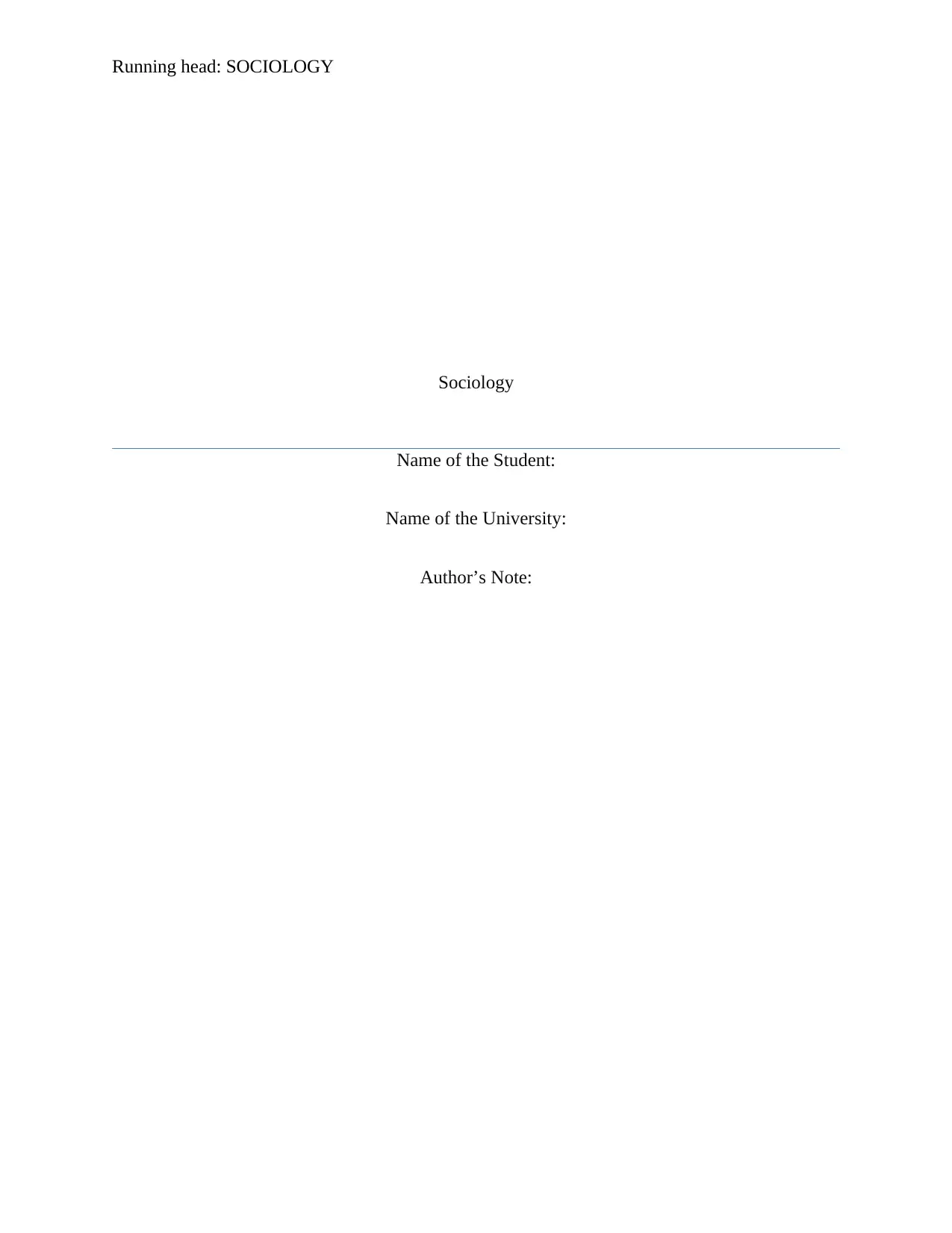
Running head: SOCIOLOGY
Sociology
Name of the Student:
Name of the University:
Author’s Note:
Sociology
Name of the Student:
Name of the University:
Author’s Note:
Paraphrase This Document
Need a fresh take? Get an instant paraphrase of this document with our AI Paraphraser
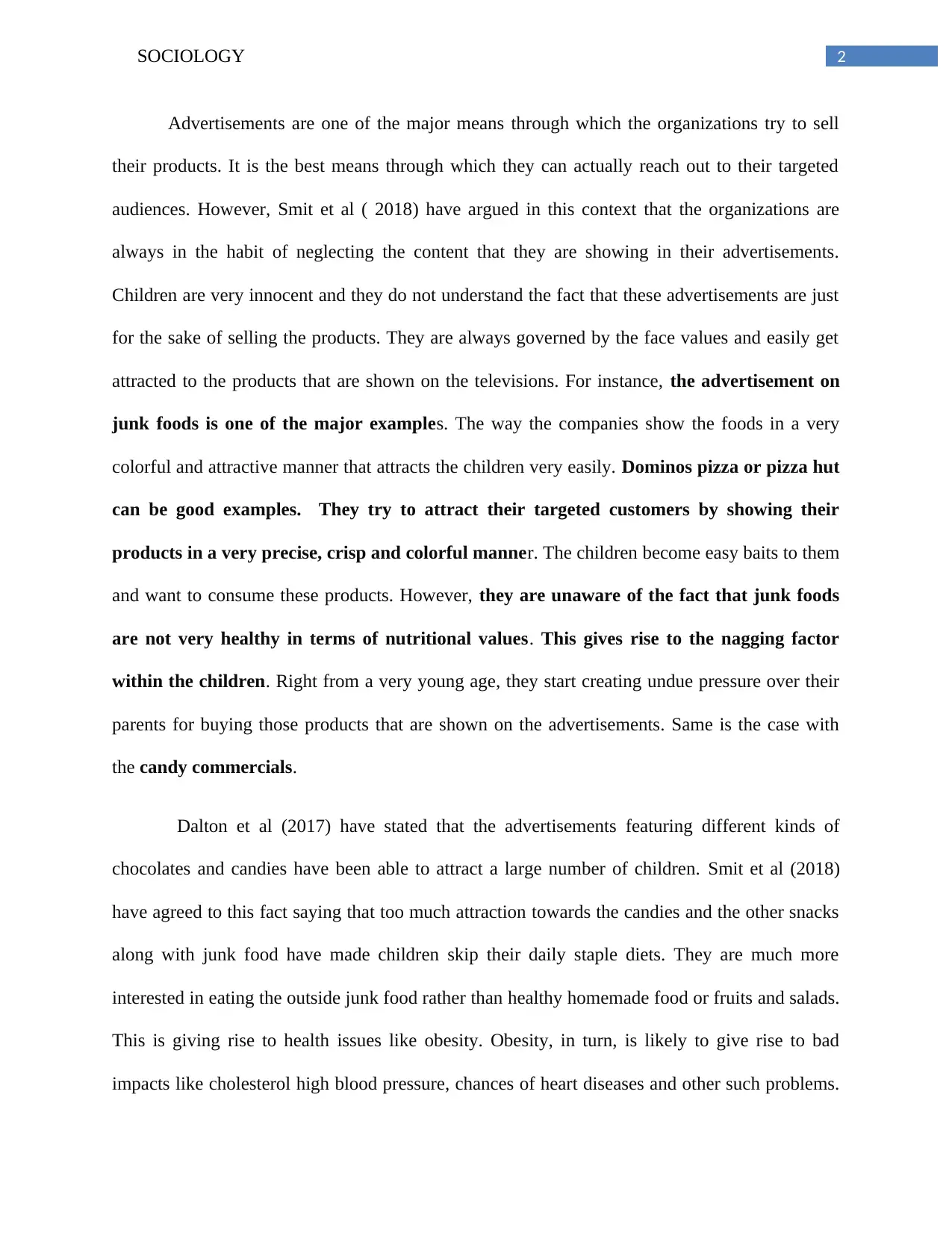
2SOCIOLOGY
Advertisements are one of the major means through which the organizations try to sell
their products. It is the best means through which they can actually reach out to their targeted
audiences. However, Smit et al ( 2018) have argued in this context that the organizations are
always in the habit of neglecting the content that they are showing in their advertisements.
Children are very innocent and they do not understand the fact that these advertisements are just
for the sake of selling the products. They are always governed by the face values and easily get
attracted to the products that are shown on the televisions. For instance, the advertisement on
junk foods is one of the major examples. The way the companies show the foods in a very
colorful and attractive manner that attracts the children very easily. Dominos pizza or pizza hut
can be good examples. They try to attract their targeted customers by showing their
products in a very precise, crisp and colorful manner. The children become easy baits to them
and want to consume these products. However, they are unaware of the fact that junk foods
are not very healthy in terms of nutritional values. This gives rise to the nagging factor
within the children. Right from a very young age, they start creating undue pressure over their
parents for buying those products that are shown on the advertisements. Same is the case with
the candy commercials.
Dalton et al (2017) have stated that the advertisements featuring different kinds of
chocolates and candies have been able to attract a large number of children. Smit et al (2018)
have agreed to this fact saying that too much attraction towards the candies and the other snacks
along with junk food have made children skip their daily staple diets. They are much more
interested in eating the outside junk food rather than healthy homemade food or fruits and salads.
This is giving rise to health issues like obesity. Obesity, in turn, is likely to give rise to bad
impacts like cholesterol high blood pressure, chances of heart diseases and other such problems.
Advertisements are one of the major means through which the organizations try to sell
their products. It is the best means through which they can actually reach out to their targeted
audiences. However, Smit et al ( 2018) have argued in this context that the organizations are
always in the habit of neglecting the content that they are showing in their advertisements.
Children are very innocent and they do not understand the fact that these advertisements are just
for the sake of selling the products. They are always governed by the face values and easily get
attracted to the products that are shown on the televisions. For instance, the advertisement on
junk foods is one of the major examples. The way the companies show the foods in a very
colorful and attractive manner that attracts the children very easily. Dominos pizza or pizza hut
can be good examples. They try to attract their targeted customers by showing their
products in a very precise, crisp and colorful manner. The children become easy baits to them
and want to consume these products. However, they are unaware of the fact that junk foods
are not very healthy in terms of nutritional values. This gives rise to the nagging factor
within the children. Right from a very young age, they start creating undue pressure over their
parents for buying those products that are shown on the advertisements. Same is the case with
the candy commercials.
Dalton et al (2017) have stated that the advertisements featuring different kinds of
chocolates and candies have been able to attract a large number of children. Smit et al (2018)
have agreed to this fact saying that too much attraction towards the candies and the other snacks
along with junk food have made children skip their daily staple diets. They are much more
interested in eating the outside junk food rather than healthy homemade food or fruits and salads.
This is giving rise to health issues like obesity. Obesity, in turn, is likely to give rise to bad
impacts like cholesterol high blood pressure, chances of heart diseases and other such problems.
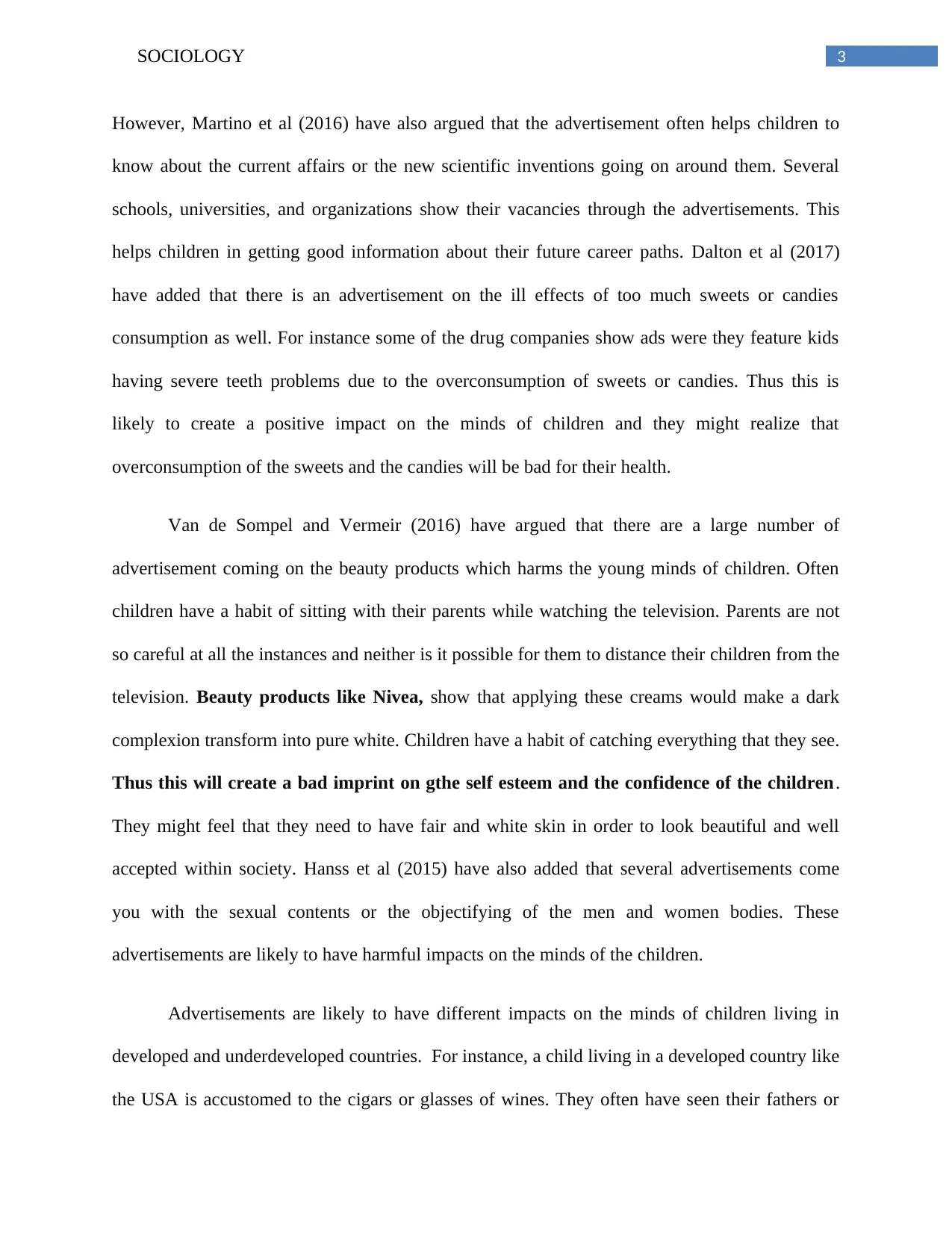
3SOCIOLOGY
However, Martino et al (2016) have also argued that the advertisement often helps children to
know about the current affairs or the new scientific inventions going on around them. Several
schools, universities, and organizations show their vacancies through the advertisements. This
helps children in getting good information about their future career paths. Dalton et al (2017)
have added that there is an advertisement on the ill effects of too much sweets or candies
consumption as well. For instance some of the drug companies show ads were they feature kids
having severe teeth problems due to the overconsumption of sweets or candies. Thus this is
likely to create a positive impact on the minds of children and they might realize that
overconsumption of the sweets and the candies will be bad for their health.
Van de Sompel and Vermeir (2016) have argued that there are a large number of
advertisement coming on the beauty products which harms the young minds of children. Often
children have a habit of sitting with their parents while watching the television. Parents are not
so careful at all the instances and neither is it possible for them to distance their children from the
television. Beauty products like Nivea, show that applying these creams would make a dark
complexion transform into pure white. Children have a habit of catching everything that they see.
Thus this will create a bad imprint on gthe self esteem and the confidence of the children.
They might feel that they need to have fair and white skin in order to look beautiful and well
accepted within society. Hanss et al (2015) have also added that several advertisements come
you with the sexual contents or the objectifying of the men and women bodies. These
advertisements are likely to have harmful impacts on the minds of the children.
Advertisements are likely to have different impacts on the minds of children living in
developed and underdeveloped countries. For instance, a child living in a developed country like
the USA is accustomed to the cigars or glasses of wines. They often have seen their fathers or
However, Martino et al (2016) have also argued that the advertisement often helps children to
know about the current affairs or the new scientific inventions going on around them. Several
schools, universities, and organizations show their vacancies through the advertisements. This
helps children in getting good information about their future career paths. Dalton et al (2017)
have added that there is an advertisement on the ill effects of too much sweets or candies
consumption as well. For instance some of the drug companies show ads were they feature kids
having severe teeth problems due to the overconsumption of sweets or candies. Thus this is
likely to create a positive impact on the minds of children and they might realize that
overconsumption of the sweets and the candies will be bad for their health.
Van de Sompel and Vermeir (2016) have argued that there are a large number of
advertisement coming on the beauty products which harms the young minds of children. Often
children have a habit of sitting with their parents while watching the television. Parents are not
so careful at all the instances and neither is it possible for them to distance their children from the
television. Beauty products like Nivea, show that applying these creams would make a dark
complexion transform into pure white. Children have a habit of catching everything that they see.
Thus this will create a bad imprint on gthe self esteem and the confidence of the children.
They might feel that they need to have fair and white skin in order to look beautiful and well
accepted within society. Hanss et al (2015) have also added that several advertisements come
you with the sexual contents or the objectifying of the men and women bodies. These
advertisements are likely to have harmful impacts on the minds of the children.
Advertisements are likely to have different impacts on the minds of children living in
developed and underdeveloped countries. For instance, a child living in a developed country like
the USA is accustomed to the cigars or glasses of wines. They often have seen their fathers or
⊘ This is a preview!⊘
Do you want full access?
Subscribe today to unlock all pages.

Trusted by 1+ million students worldwide
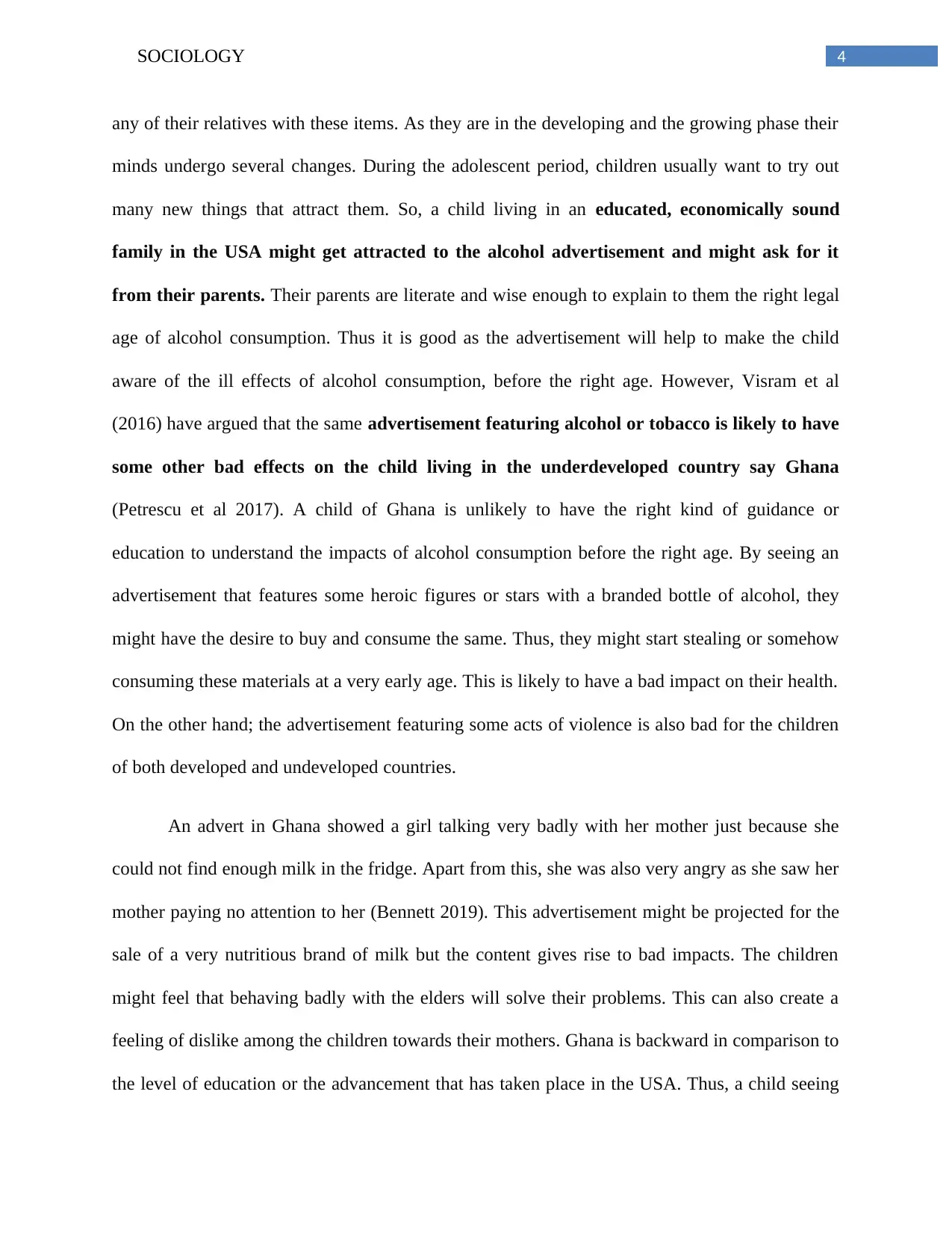
4SOCIOLOGY
any of their relatives with these items. As they are in the developing and the growing phase their
minds undergo several changes. During the adolescent period, children usually want to try out
many new things that attract them. So, a child living in an educated, economically sound
family in the USA might get attracted to the alcohol advertisement and might ask for it
from their parents. Their parents are literate and wise enough to explain to them the right legal
age of alcohol consumption. Thus it is good as the advertisement will help to make the child
aware of the ill effects of alcohol consumption, before the right age. However, Visram et al
(2016) have argued that the same advertisement featuring alcohol or tobacco is likely to have
some other bad effects on the child living in the underdeveloped country say Ghana
(Petrescu et al 2017). A child of Ghana is unlikely to have the right kind of guidance or
education to understand the impacts of alcohol consumption before the right age. By seeing an
advertisement that features some heroic figures or stars with a branded bottle of alcohol, they
might have the desire to buy and consume the same. Thus, they might start stealing or somehow
consuming these materials at a very early age. This is likely to have a bad impact on their health.
On the other hand; the advertisement featuring some acts of violence is also bad for the children
of both developed and undeveloped countries.
An advert in Ghana showed a girl talking very badly with her mother just because she
could not find enough milk in the fridge. Apart from this, she was also very angry as she saw her
mother paying no attention to her (Bennett 2019). This advertisement might be projected for the
sale of a very nutritious brand of milk but the content gives rise to bad impacts. The children
might feel that behaving badly with the elders will solve their problems. This can also create a
feeling of dislike among the children towards their mothers. Ghana is backward in comparison to
the level of education or the advancement that has taken place in the USA. Thus, a child seeing
any of their relatives with these items. As they are in the developing and the growing phase their
minds undergo several changes. During the adolescent period, children usually want to try out
many new things that attract them. So, a child living in an educated, economically sound
family in the USA might get attracted to the alcohol advertisement and might ask for it
from their parents. Their parents are literate and wise enough to explain to them the right legal
age of alcohol consumption. Thus it is good as the advertisement will help to make the child
aware of the ill effects of alcohol consumption, before the right age. However, Visram et al
(2016) have argued that the same advertisement featuring alcohol or tobacco is likely to have
some other bad effects on the child living in the underdeveloped country say Ghana
(Petrescu et al 2017). A child of Ghana is unlikely to have the right kind of guidance or
education to understand the impacts of alcohol consumption before the right age. By seeing an
advertisement that features some heroic figures or stars with a branded bottle of alcohol, they
might have the desire to buy and consume the same. Thus, they might start stealing or somehow
consuming these materials at a very early age. This is likely to have a bad impact on their health.
On the other hand; the advertisement featuring some acts of violence is also bad for the children
of both developed and undeveloped countries.
An advert in Ghana showed a girl talking very badly with her mother just because she
could not find enough milk in the fridge. Apart from this, she was also very angry as she saw her
mother paying no attention to her (Bennett 2019). This advertisement might be projected for the
sale of a very nutritious brand of milk but the content gives rise to bad impacts. The children
might feel that behaving badly with the elders will solve their problems. This can also create a
feeling of dislike among the children towards their mothers. Ghana is backward in comparison to
the level of education or the advancement that has taken place in the USA. Thus, a child seeing
Paraphrase This Document
Need a fresh take? Get an instant paraphrase of this document with our AI Paraphraser
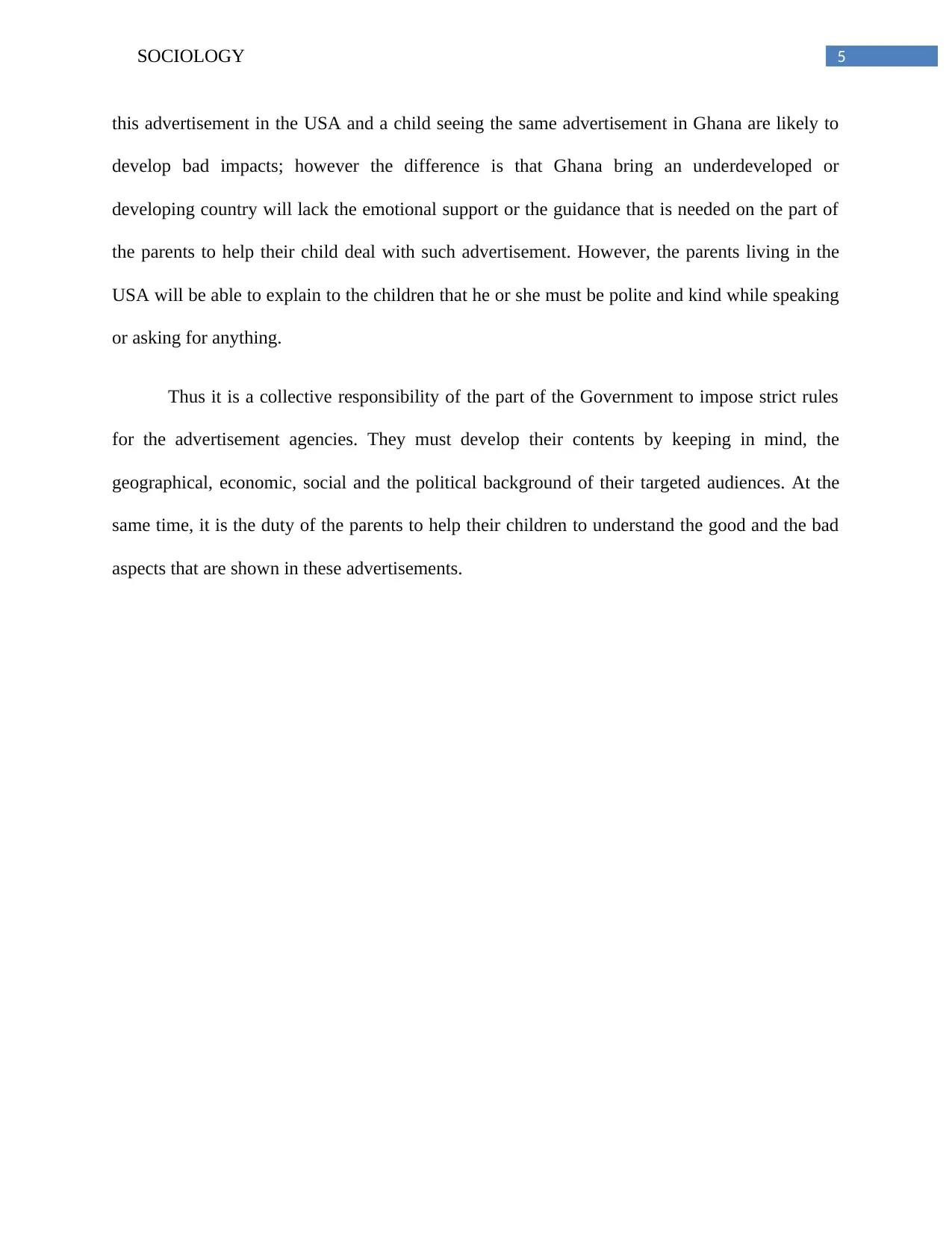
5SOCIOLOGY
this advertisement in the USA and a child seeing the same advertisement in Ghana are likely to
develop bad impacts; however the difference is that Ghana bring an underdeveloped or
developing country will lack the emotional support or the guidance that is needed on the part of
the parents to help their child deal with such advertisement. However, the parents living in the
USA will be able to explain to the children that he or she must be polite and kind while speaking
or asking for anything.
Thus it is a collective responsibility of the part of the Government to impose strict rules
for the advertisement agencies. They must develop their contents by keeping in mind, the
geographical, economic, social and the political background of their targeted audiences. At the
same time, it is the duty of the parents to help their children to understand the good and the bad
aspects that are shown in these advertisements.
this advertisement in the USA and a child seeing the same advertisement in Ghana are likely to
develop bad impacts; however the difference is that Ghana bring an underdeveloped or
developing country will lack the emotional support or the guidance that is needed on the part of
the parents to help their child deal with such advertisement. However, the parents living in the
USA will be able to explain to the children that he or she must be polite and kind while speaking
or asking for anything.
Thus it is a collective responsibility of the part of the Government to impose strict rules
for the advertisement agencies. They must develop their contents by keeping in mind, the
geographical, economic, social and the political background of their targeted audiences. At the
same time, it is the duty of the parents to help their children to understand the good and the bad
aspects that are shown in these advertisements.
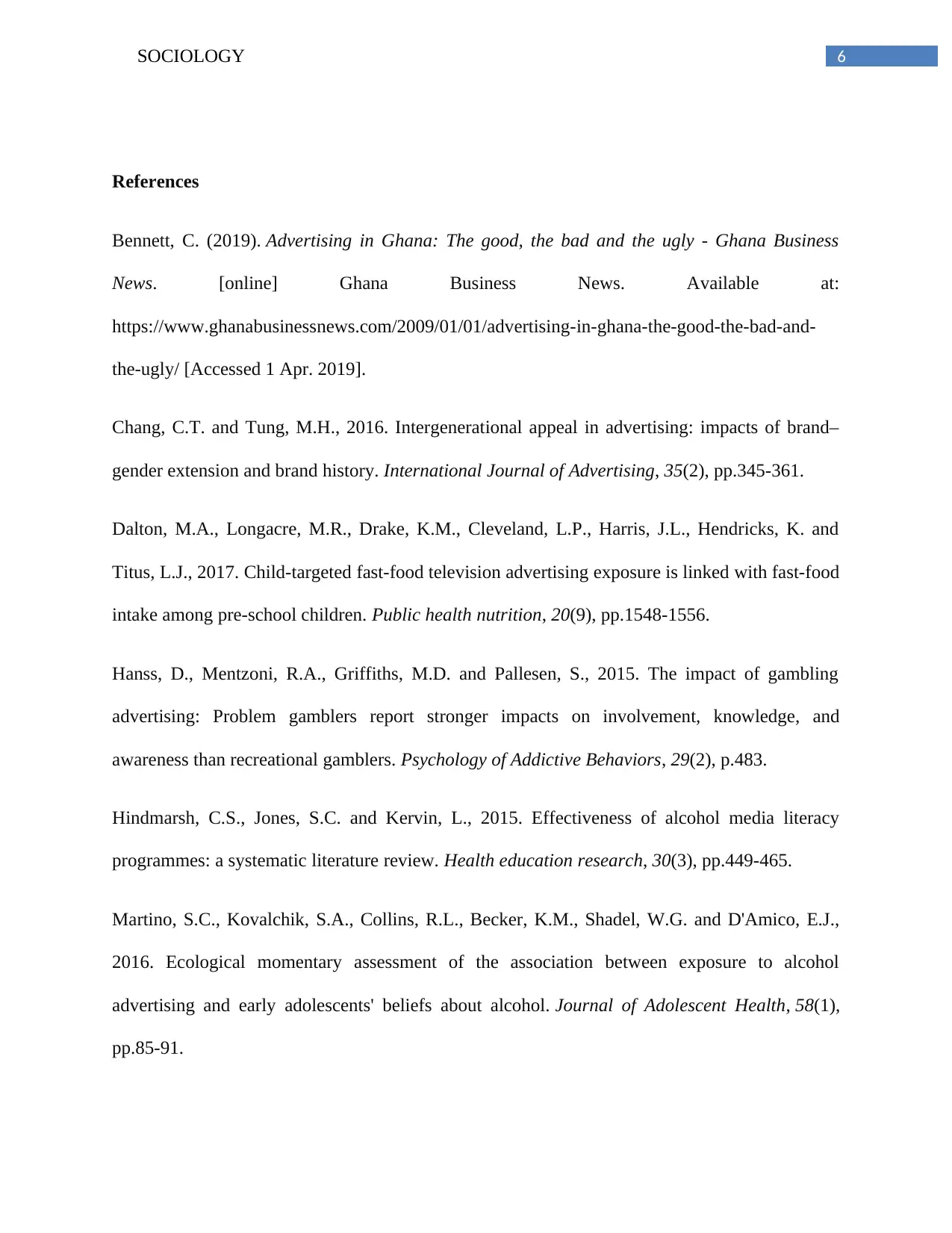
6SOCIOLOGY
References
Bennett, C. (2019). Advertising in Ghana: The good, the bad and the ugly - Ghana Business
News. [online] Ghana Business News. Available at:
https://www.ghanabusinessnews.com/2009/01/01/advertising-in-ghana-the-good-the-bad-and-
the-ugly/ [Accessed 1 Apr. 2019].
Chang, C.T. and Tung, M.H., 2016. Intergenerational appeal in advertising: impacts of brand–
gender extension and brand history. International Journal of Advertising, 35(2), pp.345-361.
Dalton, M.A., Longacre, M.R., Drake, K.M., Cleveland, L.P., Harris, J.L., Hendricks, K. and
Titus, L.J., 2017. Child-targeted fast-food television advertising exposure is linked with fast-food
intake among pre-school children. Public health nutrition, 20(9), pp.1548-1556.
Hanss, D., Mentzoni, R.A., Griffiths, M.D. and Pallesen, S., 2015. The impact of gambling
advertising: Problem gamblers report stronger impacts on involvement, knowledge, and
awareness than recreational gamblers. Psychology of Addictive Behaviors, 29(2), p.483.
Hindmarsh, C.S., Jones, S.C. and Kervin, L., 2015. Effectiveness of alcohol media literacy
programmes: a systematic literature review. Health education research, 30(3), pp.449-465.
Martino, S.C., Kovalchik, S.A., Collins, R.L., Becker, K.M., Shadel, W.G. and D'Amico, E.J.,
2016. Ecological momentary assessment of the association between exposure to alcohol
advertising and early adolescents' beliefs about alcohol. Journal of Adolescent Health, 58(1),
pp.85-91.
References
Bennett, C. (2019). Advertising in Ghana: The good, the bad and the ugly - Ghana Business
News. [online] Ghana Business News. Available at:
https://www.ghanabusinessnews.com/2009/01/01/advertising-in-ghana-the-good-the-bad-and-
the-ugly/ [Accessed 1 Apr. 2019].
Chang, C.T. and Tung, M.H., 2016. Intergenerational appeal in advertising: impacts of brand–
gender extension and brand history. International Journal of Advertising, 35(2), pp.345-361.
Dalton, M.A., Longacre, M.R., Drake, K.M., Cleveland, L.P., Harris, J.L., Hendricks, K. and
Titus, L.J., 2017. Child-targeted fast-food television advertising exposure is linked with fast-food
intake among pre-school children. Public health nutrition, 20(9), pp.1548-1556.
Hanss, D., Mentzoni, R.A., Griffiths, M.D. and Pallesen, S., 2015. The impact of gambling
advertising: Problem gamblers report stronger impacts on involvement, knowledge, and
awareness than recreational gamblers. Psychology of Addictive Behaviors, 29(2), p.483.
Hindmarsh, C.S., Jones, S.C. and Kervin, L., 2015. Effectiveness of alcohol media literacy
programmes: a systematic literature review. Health education research, 30(3), pp.449-465.
Martino, S.C., Kovalchik, S.A., Collins, R.L., Becker, K.M., Shadel, W.G. and D'Amico, E.J.,
2016. Ecological momentary assessment of the association between exposure to alcohol
advertising and early adolescents' beliefs about alcohol. Journal of Adolescent Health, 58(1),
pp.85-91.
⊘ This is a preview!⊘
Do you want full access?
Subscribe today to unlock all pages.

Trusted by 1+ million students worldwide
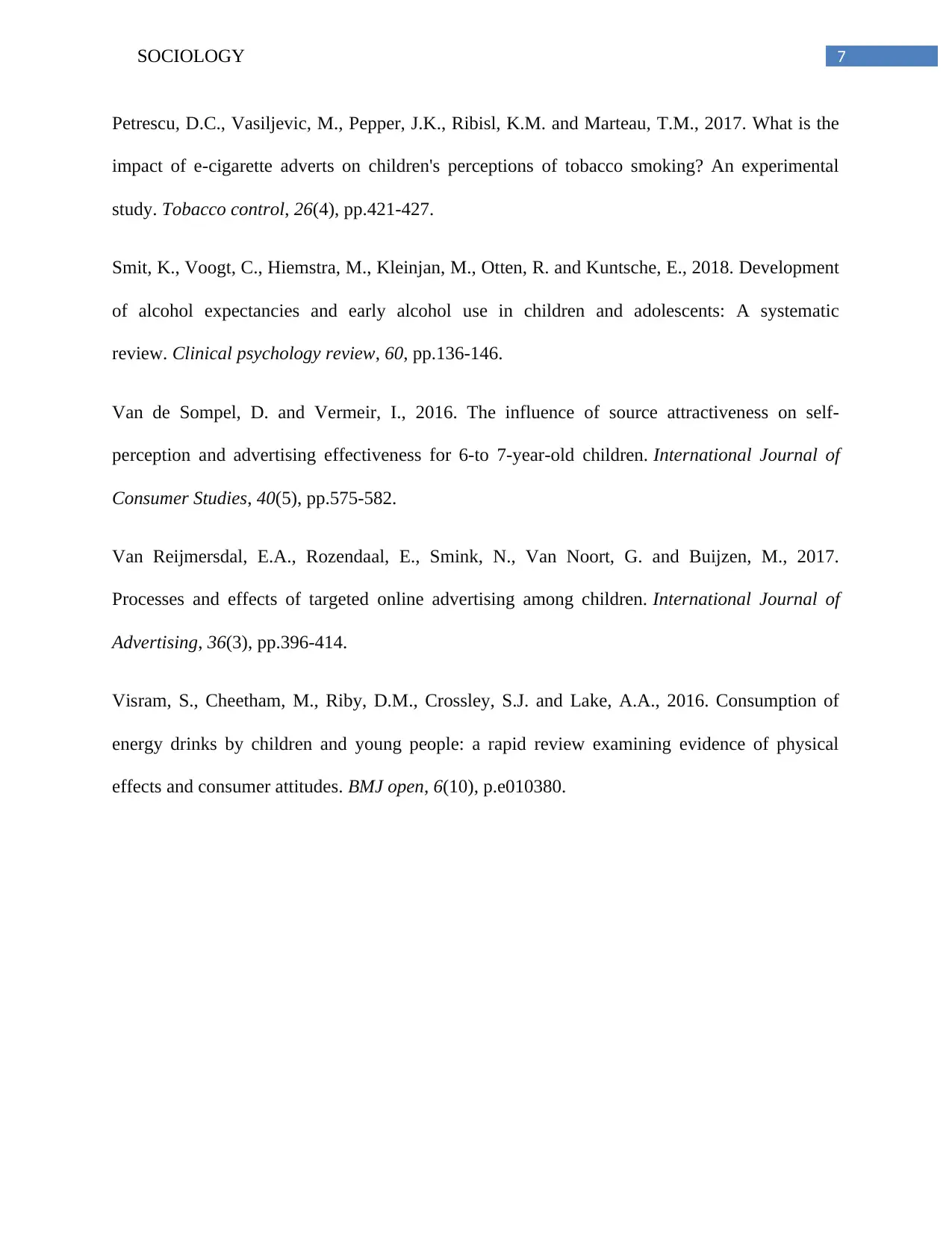
7SOCIOLOGY
Petrescu, D.C., Vasiljevic, M., Pepper, J.K., Ribisl, K.M. and Marteau, T.M., 2017. What is the
impact of e-cigarette adverts on children's perceptions of tobacco smoking? An experimental
study. Tobacco control, 26(4), pp.421-427.
Smit, K., Voogt, C., Hiemstra, M., Kleinjan, M., Otten, R. and Kuntsche, E., 2018. Development
of alcohol expectancies and early alcohol use in children and adolescents: A systematic
review. Clinical psychology review, 60, pp.136-146.
Van de Sompel, D. and Vermeir, I., 2016. The influence of source attractiveness on self‐
perception and advertising effectiveness for 6‐to 7‐year‐old children. International Journal of
Consumer Studies, 40(5), pp.575-582.
Van Reijmersdal, E.A., Rozendaal, E., Smink, N., Van Noort, G. and Buijzen, M., 2017.
Processes and effects of targeted online advertising among children. International Journal of
Advertising, 36(3), pp.396-414.
Visram, S., Cheetham, M., Riby, D.M., Crossley, S.J. and Lake, A.A., 2016. Consumption of
energy drinks by children and young people: a rapid review examining evidence of physical
effects and consumer attitudes. BMJ open, 6(10), p.e010380.
Petrescu, D.C., Vasiljevic, M., Pepper, J.K., Ribisl, K.M. and Marteau, T.M., 2017. What is the
impact of e-cigarette adverts on children's perceptions of tobacco smoking? An experimental
study. Tobacco control, 26(4), pp.421-427.
Smit, K., Voogt, C., Hiemstra, M., Kleinjan, M., Otten, R. and Kuntsche, E., 2018. Development
of alcohol expectancies and early alcohol use in children and adolescents: A systematic
review. Clinical psychology review, 60, pp.136-146.
Van de Sompel, D. and Vermeir, I., 2016. The influence of source attractiveness on self‐
perception and advertising effectiveness for 6‐to 7‐year‐old children. International Journal of
Consumer Studies, 40(5), pp.575-582.
Van Reijmersdal, E.A., Rozendaal, E., Smink, N., Van Noort, G. and Buijzen, M., 2017.
Processes and effects of targeted online advertising among children. International Journal of
Advertising, 36(3), pp.396-414.
Visram, S., Cheetham, M., Riby, D.M., Crossley, S.J. and Lake, A.A., 2016. Consumption of
energy drinks by children and young people: a rapid review examining evidence of physical
effects and consumer attitudes. BMJ open, 6(10), p.e010380.
1 out of 7
Related Documents
Your All-in-One AI-Powered Toolkit for Academic Success.
+13062052269
info@desklib.com
Available 24*7 on WhatsApp / Email
![[object Object]](/_next/static/media/star-bottom.7253800d.svg)
Unlock your academic potential
Copyright © 2020–2025 A2Z Services. All Rights Reserved. Developed and managed by ZUCOL.




